The last few years have been historic ones in terms of the fight for equality. The LGBTQ community has certainly experienced some setbacks in our fight for equality, but we have also celebrated hard won victories. One of the most notable has, of course, been achieving marriage equality as a federally protected status. It’s created a whole new market for everything from gay friend wedding planning to gay engagement rings.
Once the Supreme Court handed down their landmark decision, LGBT couples – along with many straight allies – finally felt they could walk down the aisle with their heads held high. This changed the way many venues, planning companies and other wedding service providers advertised their services as well as the actual services they offered.
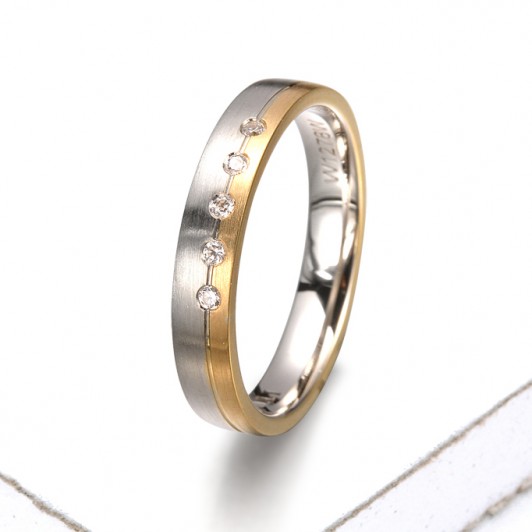
The Ares Engagement Ring, available through Equalli.
While the message was all about marriage equality, the truth is that these historic events did change the way marriage is seen, perceived and experienced for many couples. These differences reflect not only the diversity the LGBTQ community brings to the wedding experience but also the unique issues and challenges these kinds of weddings can present. For the most part “gay weddings” aren’t any different from any other kind of wedding but, at the same time, they are unique. Serious issues like vetting venues and ensuring guests safety at destination weddings are often more an issue. On the other end of the spectrum, more mundane and seemingly “light” problems like finding suits tailored for a woman’s body are common.
LGBTQ couples have also found ways to update and revamp various wedding traditions. Sometimes brides have a double wedding party with two maids of honor and multiple bridesmaids. Or maybe the two grooms opt for a shared wedding party headed by a Best Man or their own Best Woman. Mixing, matching and customizing everything from wedding parties to what the couples wear has made it so that modern weddings are a true personal reflection of a couple. Although many wedding traditions remain in place, they’ve simply been updated to reflect the changing social and cultural perceptions as well as being more in line with what each couple wants for the Big Day.
Gay Engagement Rings – A Tradition Worth Keeping?
There are basically two schools of thought when it comes to engagement rings in general. There are those who see it as a wholesome and lovely tradition which gives brides the chance to create a beautiful wedding set she can wear forever. Ten there are those who thing a wedding ring on its own is fine enough and that money spent on an engagement ring can be put to better use.
First, let’s be clear about why engagement rings are even a thing to begin with. In the United States, engagement rings weren’t commonplace until the 1940s. That’s not to say engagement rings don’t have a long history – technically they’ve been in use to some degree since the ancient Romans developed the practice. (LINK) The historical use of rings aside, engagement rings as we know them today can be traced back to diamond industry behemoth De Beers.
The campaign to increase the demand for diamond rings was predicated on two truths developed directly by the De Beers team. The first was that diamonds were rare; the second that diamonds were the best choice for engagement rings. Neither statement was objectively true.
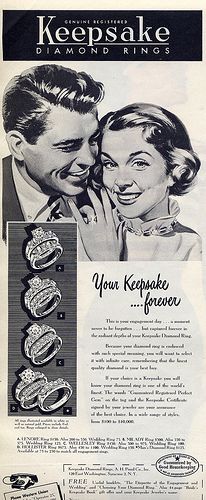
A retro engagement ad touting only diamond rings and, of course, for the only couple ads catered to in the 40s. (Photo from Millie Motts, Flicker)
In fact, De Beers was created as a direct response the the flooding of the market by diamonds in the late 19th century. The businessmen operating the mines in South Africa recognized that their precious stones would only be valuable if the public saw them as rare. So they formed De Beers Consolidated Mines, a South African based cartel which strictly ruled the sale and transportation of diamonds all over the world. By restricting their movement and sale, they were able to give the impression that diamonds were extremely rare.
As far as diamonds being the Go To options for engagement rings, that was the brainchild of the newly formed De Beers Consolidated Mines as well. In the 1940s, the company teamed up with a marketing team that proposed a series of lectures at high schools across the country. In each lecture, speakers extolled the virtues of diamond rings. They delivered unashamed, blatant advertising hype creating a demand for a product they alone controlled.
Given the diamond engagement ring’s somewhat shady origin, it’s no wonder many couples these days have decided to skip the engagement ring completely and simply devote more of their budget to creating custom wedding ring sets or other wedding related expenses. Still there are those who want to include engagement rings in their own wedding plans and, for them, a new approach to weddings and marriage means a new approach to wedding jewelry.
LGBT Engagement and Wedding Sets
Traditionally, women have worn engagement rings upon which they added a band in order to create a larger and dazzling set while men sported a simple wedding band once they were married. One of the biggest changes that happened to wedding jewelry over the past few years has been a huge change in the options for men and the flexibility for women. LGBTQ couples have helped to create a whole new approach to engagement rings and wedding sets that has gone positively mainstream.
Many gay men opt now for engagement rings which they add to with a wedding rings once they have walked down the aisle. While the surge in gay couples may have fueled a newfound popularity of engagement rings for men, the idea of men sporting rings before the Big Day isn’t actually new. In Chile, for example, both men and women wear engagement rings which they wear on their right hand until the are officially wed. They move the rings over to their left hands as a part of the marriage ceremony. In Nordic countries, including Sweden, men are just as likely to sport engagement rings as their female counterparts. So the practice isn’t rare, but it is fairly new to most areas of the United States.
A handful of jewelers have begun to design engagement rings for men. Like traditional sets, men’s engagement rings are designed to be both dazzling in their own right and able to pair well with complementary rings. In the mainstream styles tend to mirror the styles originally forged by women’s rings. Men can choose form diamond studded eternity style rings to simple bands with and without gemstone accents.
So what are people talking about when they talk about gay engagement rings? Usually it’s in reference to how colorful or blingy an engagement set might be. Or it could be in reference to Rainbow Pride engagement rings. But more often than not, it’s simply a shorthand way to acknowledge it’s a set that will be used for a same sex couple. Since both men will be wearing rings, it does open some opportunity for customization and shared designs.
In most respects, there is no difference between gay engagement rings and those used by other couples. But there are some engagement rings designed with same sex couples in mind. These sets are designed to be gorgeous stand alone pieces as well as coming together to create something even more beautiful.
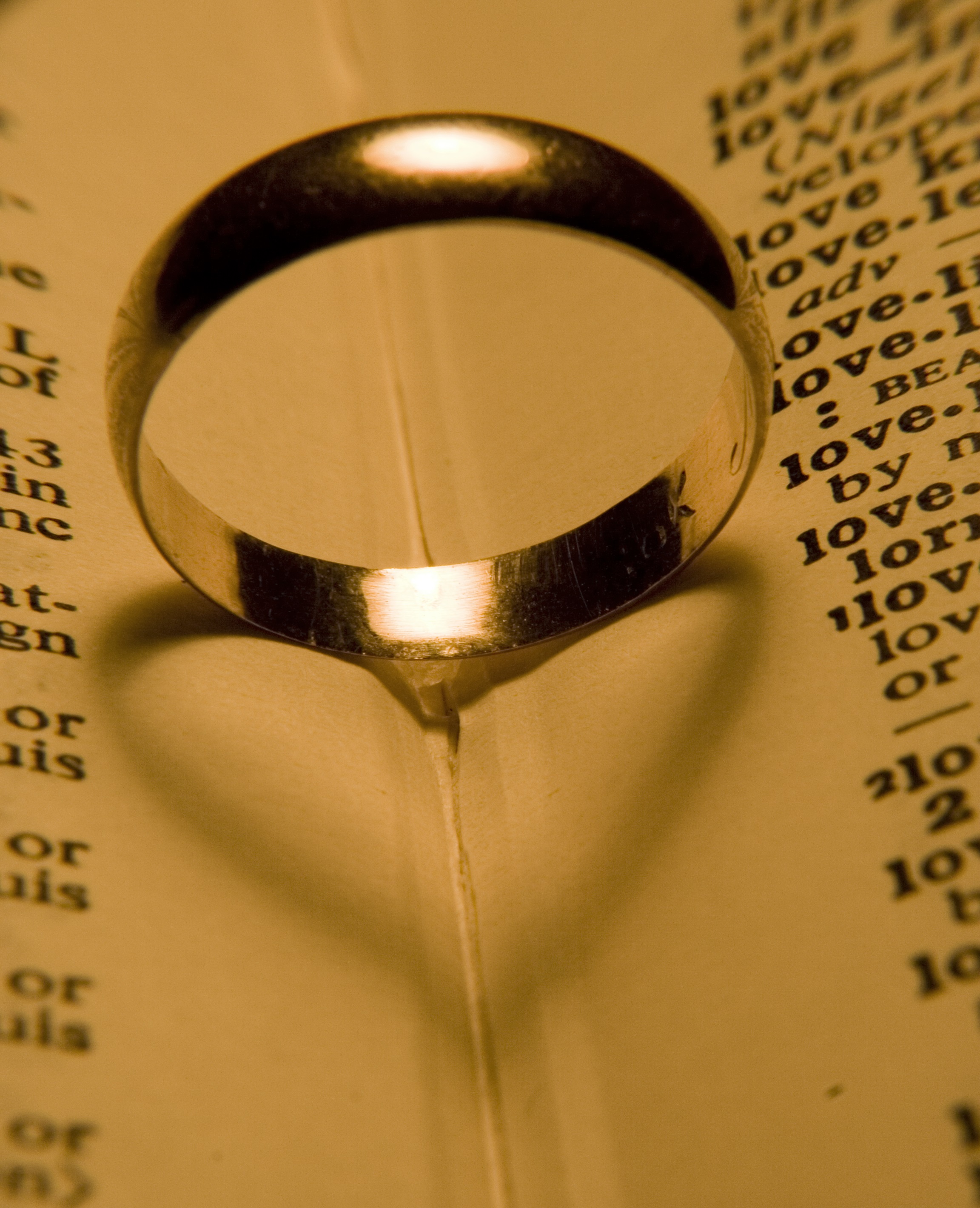

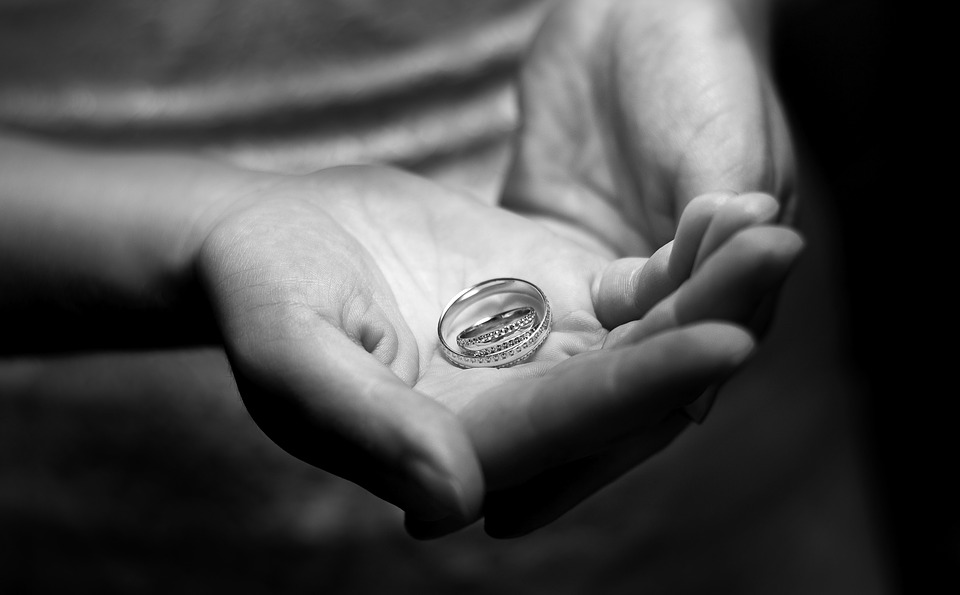


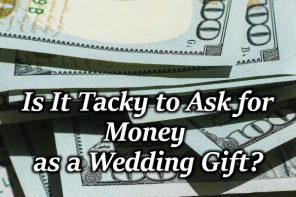

In regards to this, I am going to be proposing to my boyfriend. We are a gay couple and happy to get married. However, with me proposing and being gay I feel like there’s a difference. Heterosexual couples propose with a big beautiful ring and then have the simpler one on the wedding day. For us, its awkward… do we do the same? How does that work? Do gays usually have an engagement ring and a wedding ring? How does this work? Thank you for your help.
Best,
Caleb and Logan Kirkpatrick-Dirickson